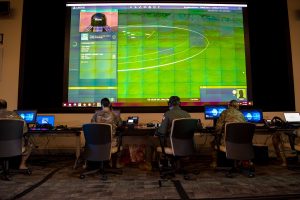A House Armed Services Committee cyber panel wants information on the full scope of the Pentagon’s Joint All Domain Command and Control (JADC2) effort, citing concerns over a lack of clarity on the cost and schedule for specific programs under the initiative.
The House Armed Subcommittee on Cyber, Innovative Technologies, and Information Systems’ (CITI) markup for the fiscal year 2023 National Defense Authorization Act, released Tuesday and set to be considered Wednesday, includes a provision that would direct a Government Accountability Office (GAO) report evaluating the Pentagon’s JADC2 plans.

“The committee is concerned about the Department of Defense’s progress in implementing the Joint All-Domain Command and Control concept. The committee recognizes the Department has made progress on JADC2 planning, but each of the military services has a separate effort to address the Department’s JADC2 requirements concept, and it is unclear what capabilities will be delivered to the warfighter, how much they will cost, and when they will be delivered,” the panel wrote in its mark.
Committee staff told reporters ahead of the mark’s release the JADC2 directive is not intended to be a “punitive, what went wrong” look at the program, but rather is focused on getting a cohesive look at the “unprecedented effort” and how Congress can best support the initiative.
“JADC2 is a very complex undertaking, as you all are aware, and there are a lot of pieces that all need to come together in order to create this capability that the department’s depending on. The services have their specific efforts that may be succeeding or encountering challenges, each on their own merits, and they’re supposed to net together into this cohesive whole. So this is really [about] alignment and supervision,” a committee staff member said. “From the members, there was a demand signal to just understand and get an outside objective perspective on where the program is at or where the effort is at given just how important it will be and is to the department.”
Defense Secretary Lloyd Austin approved DoD’s JADC2 strategy last May, which aims to bring in joint technologies, ranging from artificial intelligence to new advanced computing tools, to build a cross-service digital architecture for future multi-domain operations (Defense Daily, June 4).
The far-reaching plan, which aims to underpin the department’s Joint Warfighting Concept for future operations, incorporates initiatives such as Navy’s Project Overmatch, the Air Force’s Advanced Battle Management System and the Army’s Project Convergence.
The panel’s mark would direct the Pentagon to submit a report to HASC by the end of 2022 detailing the full scope of JADC2- related development efforts, to include each program’s cost and schedule projections, a description of how each effort contributed to JADC2 goals and a list of JADC2 capability gaps and how the department plans to address those areas.
GAO would be required to brief HASC on its review of JADC2 by the end of March 2023, with the panel calling for the report to provide an overview of the Pentagon’s JADC2 investment plans, an evaluation on the department’s processes for monitoring JADC2-related cost and schedule parameters and an assessment of challenges in getting after the initiative’s stated goals.
Following the HASC CITI Subcommittee’s mark on Wednesday, the full committee is set to consider the next NDAA and a bevy of amendments on June 22.
Rep. Jim Langevin (D-R.I.), the subcommittee’s chair and a top legislator on cyber security-related issues, announced in January he will not seek reelection in 2022 (Defense Daily, Jan. 18).